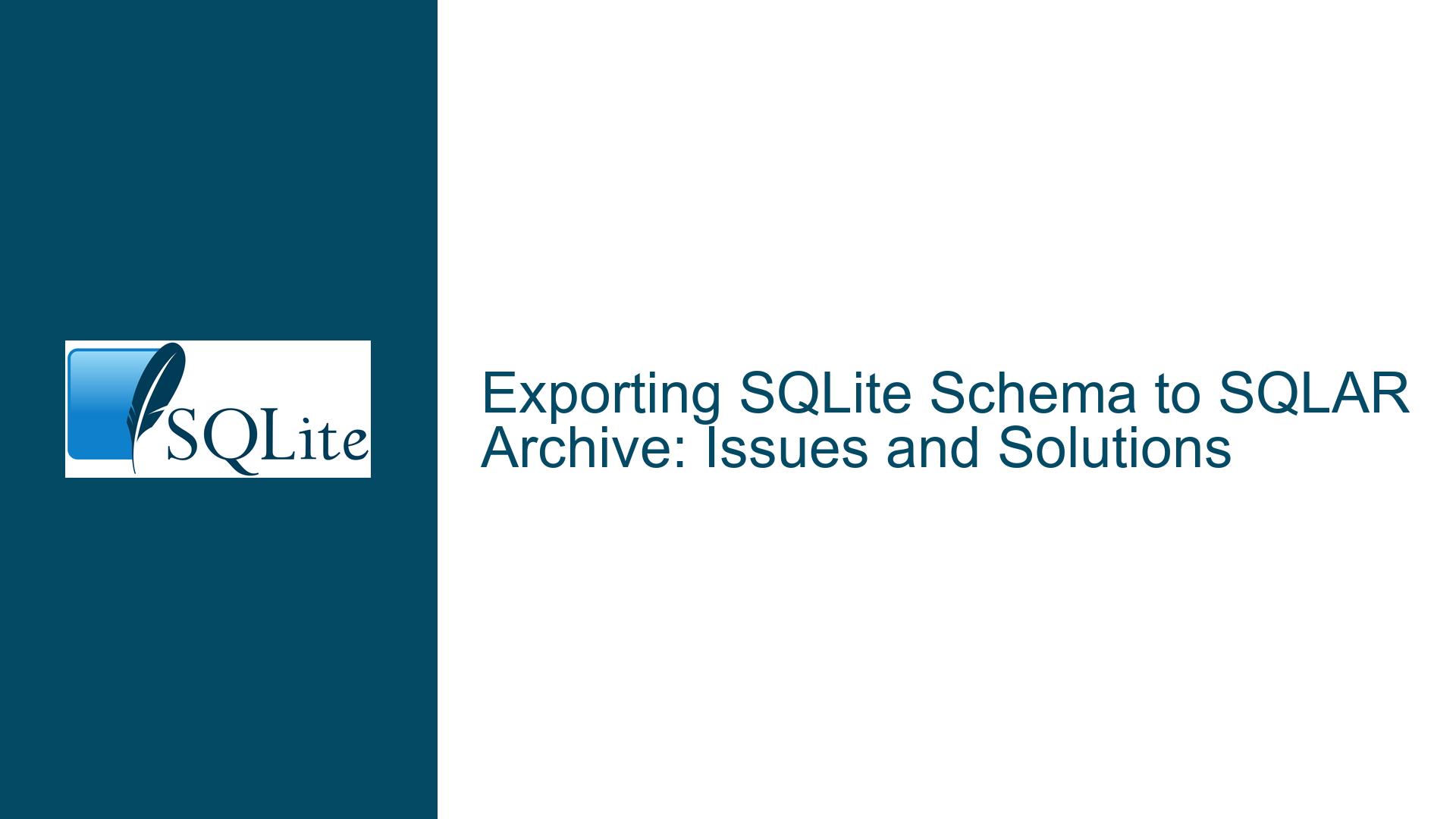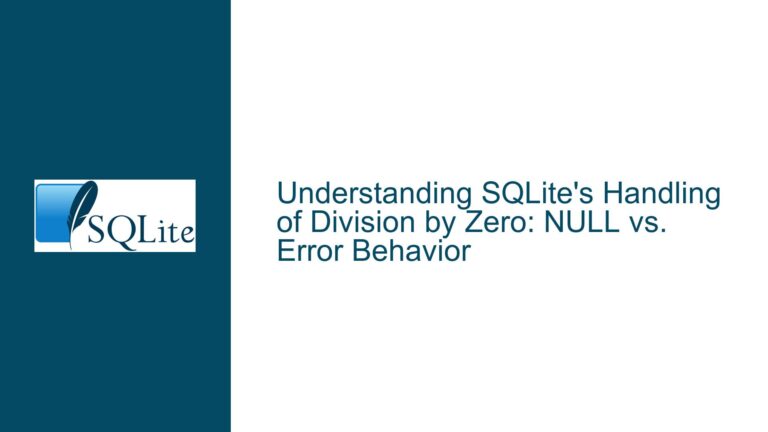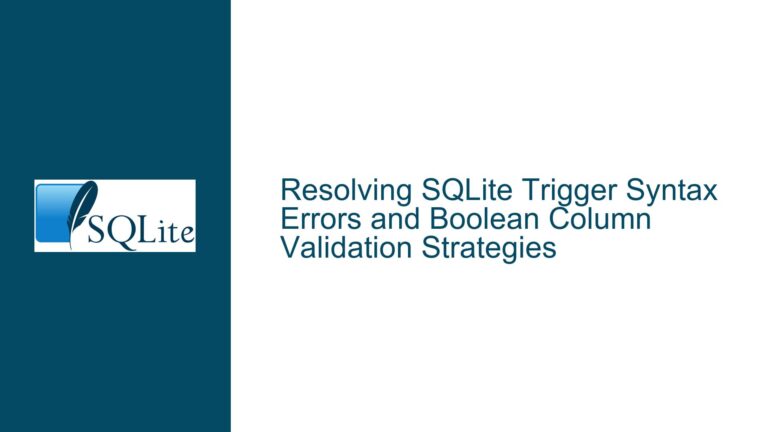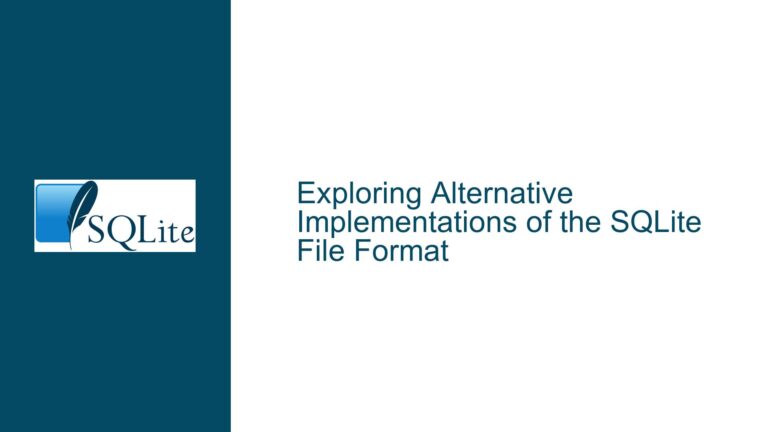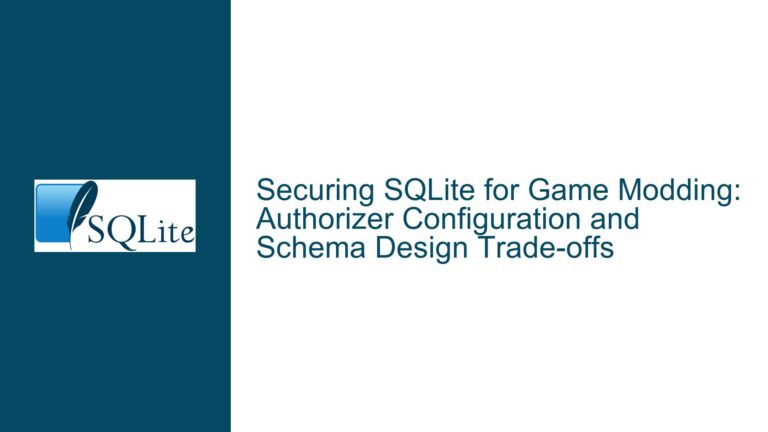Exporting SQLite Schema to SQLAR Archive: Issues and Solutions
Understanding the SQLAR Export Process and Its Challenges
The process of exporting a SQLite database schema into an SQLAR archive involves several intricate steps, each of which can introduce potential issues. The goal is to extract the schema definitions—tables, indexes, views, and triggers—into separate SQL files, which are then bundled into an SQLAR archive. This archive can later be used to reconstruct the schema in another SQLite database. While the provided SQL script automates much of this process, there are nuances and potential pitfalls that can lead to errors or incomplete exports.
The SQLAR facility in SQLite is designed to store files in a compressed format within the database itself. When exporting schema definitions, the script traverses the sqlite_master table, which contains the schema information for all database objects. It then generates SQL files for each object, organizes them into directories based on their type (e.g., tables, indexes, views, triggers), and creates a main.sql file that combines these individual files into a single script for reconstruction. However, this process relies heavily on the correctness of the SQL queries and the structure of the sqlite_master table. Any deviation from expected behavior can result in incomplete or incorrect exports.
One of the primary challenges is ensuring that the SQLAR table is correctly built and populated. The SQLAR table must exist in the database, and the script must have the necessary permissions to insert records into it. Additionally, the script assumes that the sqlite_master table contains valid and consistent schema definitions. If the database is corrupted or contains invalid entries, the export process may fail or produce incorrect results.
Another challenge is handling edge cases, such as databases with a large number of objects or objects with complex dependencies. The script uses a WITH clause to generate the SQLAR entries, which can become inefficient or fail if the database contains a large number of objects. Furthermore, the script does not handle data rows, meaning that only the schema is exported. This limitation must be clearly understood to avoid confusion when attempting to reconstruct the database.
Diagnosing Common Issues in SQLAR Schema Exports
When exporting a SQLite schema to an SQLAR archive, several common issues can arise. These issues often stem from incorrect assumptions about the database structure, limitations in the SQLAR facility, or errors in the SQL script itself. Understanding these issues is crucial for diagnosing and resolving problems during the export process.
One common issue is the failure to create or populate the SQLAR table. The SQLAR table must exist in the database before running the export script. If the table is missing or incorrectly configured, the script will fail to insert the generated SQL files into the archive. This issue can be diagnosed by checking the database schema for the presence of the SQLAR table and verifying that it has the correct structure. The SQLAR table should have columns for name, mode, mtime, sz, and data, as defined in the SQLite documentation.
Another frequent issue is the incorrect handling of object dependencies. The script generates SQL files for each object in the sqlite_master table but does not account for dependencies between objects. For example, a view that depends on a table must be created after the table. If the main.sql file does not order the .read commands correctly, the reconstruction process may fail. This issue can be diagnosed by examining the main.sql file and verifying that the .read commands are ordered correctly based on object dependencies.
A third issue is the incomplete export of schema objects. The script excludes certain objects, such as those with names starting with sqlite_autoindex. While this exclusion is intentional, it can lead to confusion if the database contains custom objects with similar naming conventions. Additionally, the script does not export data rows, which can be a significant limitation for databases where data preservation is critical. This issue can be diagnosed by comparing the exported SQL files to the original database schema and verifying that all relevant objects are included.
Finally, performance issues can arise when exporting large or complex schemas. The script uses a WITH clause to generate the SQLAR entries, which can become inefficient for databases with a large number of objects. This inefficiency can lead to slow export times or even script failures. Performance issues can be diagnosed by monitoring the script’s execution time and resource usage, particularly for databases with thousands of objects.
Resolving SQLAR Export Issues and Optimizing the Process
To resolve the issues identified in the SQLAR export process, several steps can be taken. These steps include verifying the SQLAR table configuration, handling object dependencies, ensuring complete schema exports, and optimizing performance for large databases. By addressing these areas, the export process can be made more reliable and efficient.
First, ensure that the SQLAR table is correctly configured. The table should be created with the following schema:
CREATE TABLE sqlar(
name TEXT PRIMARY KEY,
mode INT,
mtime INT,
sz INT,
data BLOB
);
If the table is missing or incorrectly configured, it can be created or altered using the above schema. Additionally, verify that the script has the necessary permissions to insert records into the SQLAR table. This can be done by running a simple INSERT statement into the table and checking for errors.
Second, handle object dependencies by modifying the main.sql file generation process. The script should order the .read commands based on object dependencies. For example, tables should be created before views that depend on them. This can be achieved by analyzing the sqlite_master table and determining the dependency graph for all objects. Once the dependencies are known, the .read commands can be ordered accordingly in the main.sql file.
Third, ensure complete schema exports by modifying the script to include all relevant objects. The script should be updated to handle custom objects with names starting with sqlite_autoindex if necessary. Additionally, consider extending the script to export data rows if data preservation is required. This can be done by generating INSERT statements for each row in the database and including them in the SQLAR archive.
Finally, optimize performance for large databases by refining the SQL queries used in the export process. The WITH clause can be replaced with more efficient queries, particularly for databases with a large number of objects. Additionally, consider breaking the export process into smaller batches to reduce memory usage and improve execution time. For example, the script could export objects in groups of 100 or 1000, rather than all at once.
By following these steps, the SQLAR export process can be made more reliable and efficient, ensuring that the exported schema is complete, correctly ordered, and free from errors. This will enable users to confidently use the SQLAR archive to reconstruct their SQLite databases in other environments.
